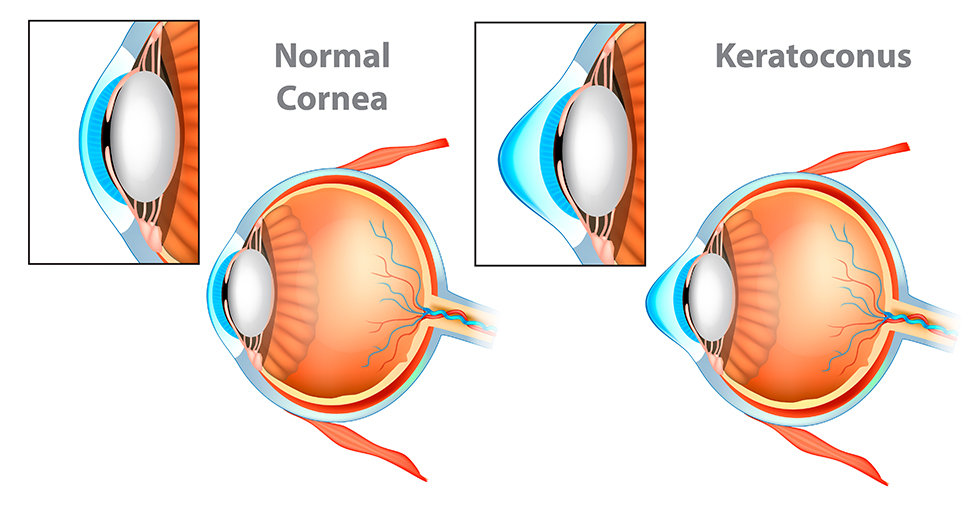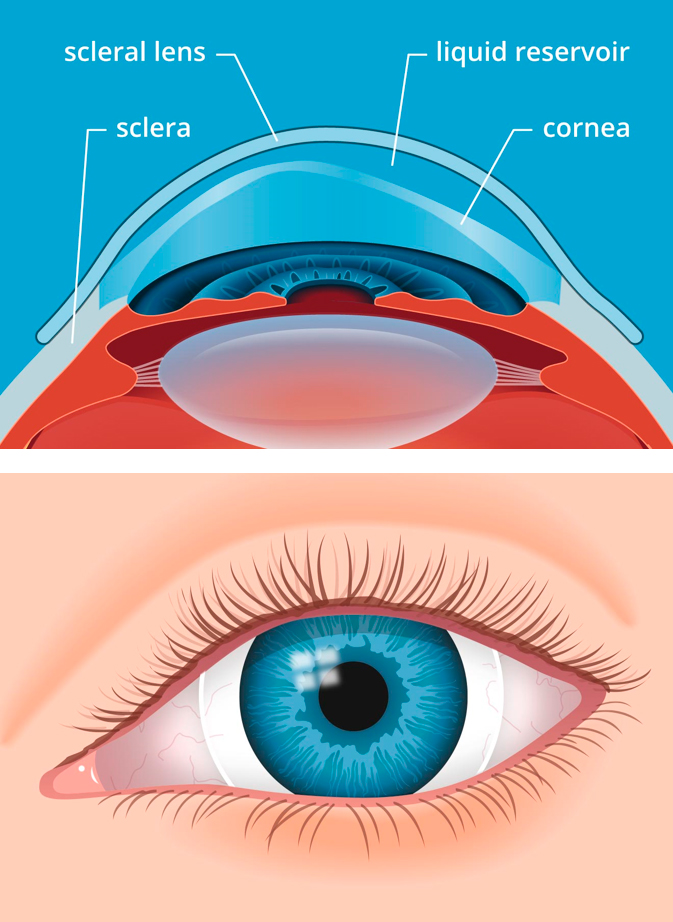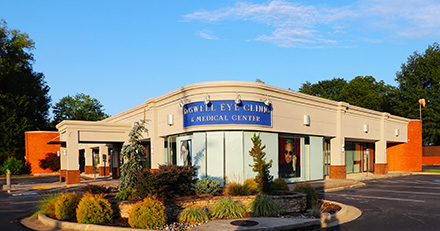Keratoconus & Specialty Lenses
Keratoconus
Keratoconus is a relatively uncommon eye condition where the cornea becomes thinner and bulges forward. The term “keratoconus” comes from the Greek terms for cornea (“kerato”) and cone-shaped (“conus”). The exact cause of keratoconus remains unknown.
Contact Lenses for Keratoconus
Standard Gas Permeable (GP) contact lenses and Scleral contact lenses are the treatment option of choice for keratoconus because they help contain the shape of the cornea to prevent further bulging of the cornea. They also can correct vision problems caused by keratoconus that cannot be corrected with eyeglasses or soft contacts.
In cases of early keratoconus, a standard GP lens may be used. However, if the lens does not center properly on the eye or moves excessively with blinks and causes discomfort, switching to a large-diameter Scleral contact lens may solve the problem.
Scleral lenses are designed to vault the corneal surface and rest on the less sensitive surface of the sclera, these lenses often are more comfortable for a person with keratoconus.
In addition, Scleral lenses are designed to fit with little or no lens movement during blinks, making them more stable on the eye, compared with traditional corneal gas permeable lenses.
Contact Lenses After Corrective Eye Surgery
More than one million Americans each year have LASIK surgery to correct their eyesight. Sometimes, vision problems remain after surgery that cannot be corrected with eyeglasses or a second surgical procedure. In these cases, standard Gas Permeable or Scleral contact lenses can often restore visual acuity and eliminate problems like glare and halos at night.
Standard Gas Permeable and Scleral contact lenses are also used to correct vision problems after corneal transplant surgery, including irregular astigmatism that cannot be corrected with eyeglasses.
Scleral Contact Lenses for Keratoconus
If you have Keratoconus or if you’ve been told in the past that you cannot wear contact lenses because of an irregular cornea or other problems, you may want to get a second opinion and ask your eye doctor about Scleral contact lenses.
Scleral contacts are large-diameter gas permeable contact lenses specially designed to vault over the entire corneal surface and rest on the “white” of the eye (sclera). In doing so, Scleral lenses functionally replace the irregular cornea with a perfectly smooth optical surface to correct vision problems caused by keratoconus and other corneal irregularities.
Also, the space between the cornea and the back surface of a Scleral lens acts as a fluid reservoir to provide comfort for people with severe dry eyes who otherwise could not tolerate contact lens wear.
Scleral Contact Lenses for Other Corneal Problems
In addition to keratoconus, Scleral contact lenses can be used for eyes that have undergone a cornea transplant, LASIK/PRK and for people with severe dry eyes caused by conditions such as Sjogren’s syndrome, graft-versus-host disease (GVHD) and Stevens-Johnson syndrome.
Advances in lens design technology are allowing manufacturers to design Scleral lenses that can correct more conditions than ever before, including bifocal Sclerals for the correction of presbyopia.
Scleral Contact Lens Fitting
Scleral contact lenses are custom-made for each wearer, so fitting Scleral contacts demands greater expertise and more time than fitting standard soft or GP contact lenses.
Often, computerized maps of the curvature of the entire cornea are generated to facilitate the lens fitting, and several trial lenses of different sizes and curvatures may be applied to the eye during the fitting process.
Also, depending on the complexity of the problem and how the individual eye tolerates the Scleral lens, adjustments of lens parameters may be needed, which will require additional lenses to be made and exchanged. The entire Scleral lens fitting process can take several visits to determine the optimal lens for each eye.
While many individuals who use Scleral lenses have worn soft or corneal GP lenses in the past, the process for applying and removing Scleral lenses may take some practice. The additional time needed to master this, due to the larger size of the lens and the fluid reservoir under the lens, needs to be taken into consideration during the fitting process.
Gas Permeable (GP) Contact Lenses
Gas Permeable (GP) contact lenses are contact lenses made of silicone-containing compounds that allow oxygen to pass through the lens material to the eye. Though not as popular as soft contact lenses, GP lenses offer a number of advantages over soft lenses.
Advantages of Gas Permeable Lenses
GP lenses allow your eyes to “breathe” better. GP lenses allow more oxygen to reach the front surface of the eye. This reduces the risk of eye problems caused by hypoxia, reduced oxygen supply. Gas Permeable lenses provide a better oxygen supply than most soft lenses because:
- The silicone-containing lens materials of GP lenses are more permeable to oxygen than many soft lens materials though new “ silicone hydrogel” soft lenses are comparable to GPs in oxygen transmission.
- GP lenses are smaller in diameter than soft lenses, so they cover up less of the cornea, the front surface of the eye.
- GP lenses hold their shape and move on the eye with each blink. This movement pumps oxygen-containing tears under the lens. Soft lenses conform to the shape of the cornea and have only minimal movement with blinks, so little or no tears circulate under soft lenses.
GP lenses provide sharper vision. GP leses are custom-made to a smooth surface and maintain their shape on the eye, GP lenses provide sharper vision than soft lenses, which can fluctuate in shape and clarity if they start to dry out. Gas permeable lenses also provide a more stable and accurate correction of astigmatism.
GP lenses are rigid, so they last longer because they wont rip or tear. They are also easier to keep clean and don’t need to be replaced frequently like soft lenses. With proper care, a single pair of GP lenses can last a year or longer. Since they are long-lasting, GP lenses can be less expensive than soft lenses in the long run.
GP lenses may slow the progression of nearsightedness. In addition to their other advantages, some research suggests that wearing gas permeable lenses may slow the progression of myopia (nearsightedness) in some children. GP lenses are also used for orthokeratology/Orthokeratology/Corneal Refractive Therapy (CRT) where specially designed contacts are worn during sleep to reshape the cornea and improve vision.
SynergEyes: The Best of Both Worlds
Since comfort is the primary barrier to GP use, an interesting innovation is the hybrid contact lens. These lenses have a GP center, surrounded by a soft lens “skirt.” The goal of hybrid lenses is to provide the clarity of a gas permeable lens and wearing comfort that rivals that of a soft lens.
Orthokeratology/Corneal Refractive Therapy (CRT)
Orthokeratology is a non-surgical procedure where you wear special gas permeable contact lenses (think of them as corneal molds) at night that reshape your cornea while you sleep. When you remove the lenses in the morning, your cornea temporarily retains the new shape, so you can see clearly during the day without glasses or contact lenses. Orthokeratology/Corneal Refractive Therapy (CRT) have been proven effective at not only correcting myopia but also slowing myopia progression. Learn more about myopia control.
Our Keratoconus & Specialty Lens Specialists: Dr. Scott Moscow, Dr. William “Billy” Moscow, Dr. Ashleigh Sprouse



